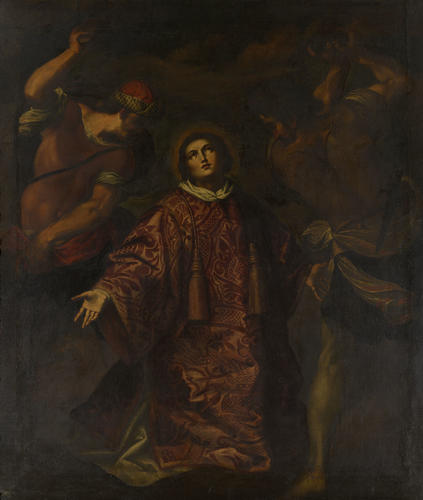-
1 of 253523 objects
The Stoning of St. Stephen c.1600-1620
Oil on canvas | 157.9 x 182.8 cm (support, canvas/panel/stretcher external) | RCIN 404968

Attributed to Spanish School, 17th century
The Stoning of St. Stephen c.1600-1620
-
St Stephen is traditionally venerated as the protomartyr; according to the New Testament Acts of the Apostles, Stephen was a deacon in the early church in Jerusalem, who was condemned to death after angering the priests of the Sanhedrin assembly. His martyrdom was witnessed by Saul of Tarsus, a Pharisee who would later become a follower of Jesus, known as St Paul. In this painting as in most depictions of the subject, St Stephen, dressed in the robes of a Deacon, is shown with eyes turned heavenward, commending his soul to God, as his executioners hurl stones at him.
The Stoning of St Stephen is first recorded in the Royal Collection during the reign of James II. It was previously attributed to the German artist Johann Rottenhammer (1564-1625), who was active in Italy at the turn of 17th century. Since the early 20th century, the painting has been attributed to the Spanish School, although it has been suggested that it may be the work of Lodovico Cardi, also known as Cigoli (1559-1613).
Almost certainly dating from the final decades of the sixteenth century or the first decades of the seventeenth century, this painting demonstrates the prevailing influence of Italy, specifically Venice, on Spanish painting of the period. The exploration of light, rendering of varied surface textures and focus on colour over line found in this painting are indicative of the influence of Venetian art, although the painting was most likely to have been painted by a Spanish artist working in Spain. During the sixteenth century, Spain's colonial and commercial outposts in Italy brought Spanish artists into contact with the latest trends in painting. In the later sixteenth century, the example of Venetian art, particularly that of Titian, captivated Spanish painters. While some travelled to Italy to study first hand or were exposed to works by Italian artists in Habsburg royal collection, most learned from the many copies of Titian, Veronese, and Tintoretto's works that circulated in the country.
Provenance
First recorded in the Old Gallery at Windsor Castle in 1688 (No 839); in the Privy Chamber at Windsor in 1710 (No 45) and throughout the 18th century.
-
Creator(s)
(nationality) -
Medium and techniques
Oil on canvas
Measurements
157.9 x 182.8 cm (support, canvas/panel/stretcher external)
206.1 x 180.3 x 8.3 cm (frame, external)
Alternative title(s)
The Martyrdom of St. Stephen